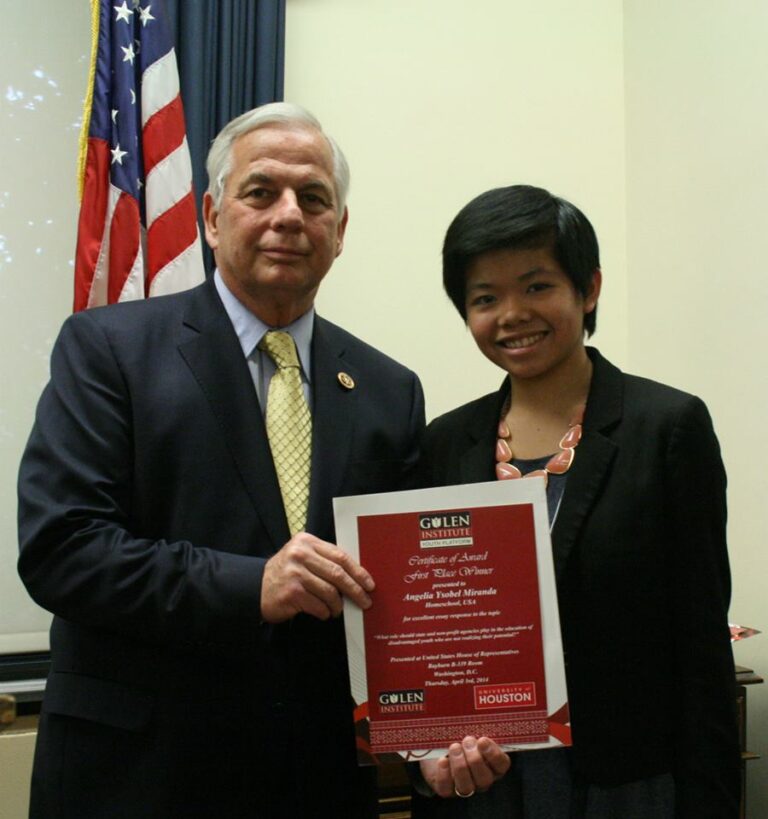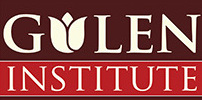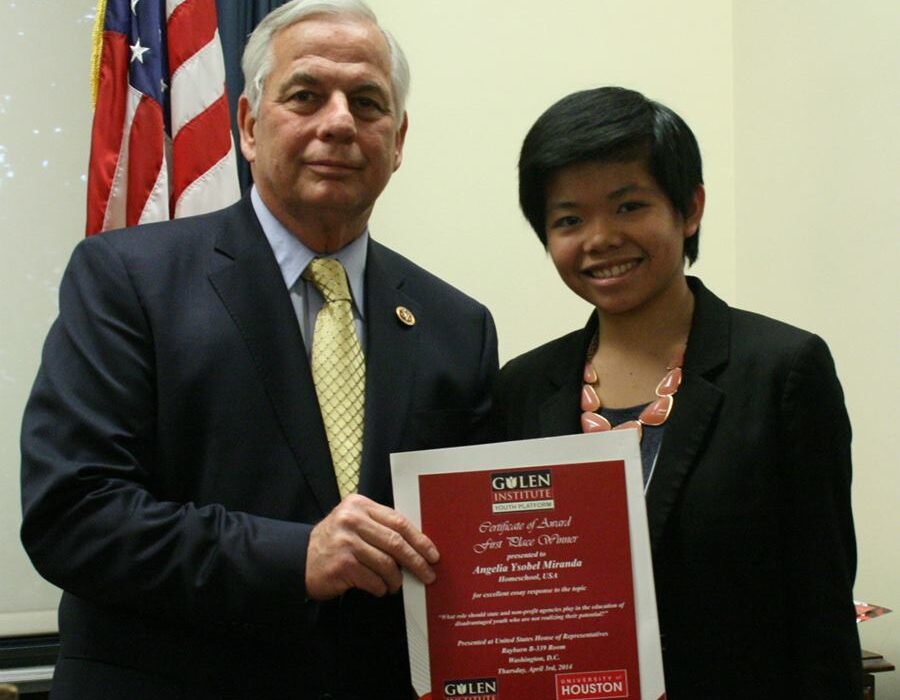
Angelia Ysobel Miranda |
USA, Home School 10th Grade |
1st Place Winner |
The light and heat left over from the summer was fading away, and she quickened her pace. During the five minute walk to the cluster of portables the district referred to as school, if she looked closely enough, she could make out the traces of fall in the leaves…
“An event may be small and insignificant in its origin, and yet, when drawn close to one’s eye, it may open in its center an infinite and radiant perspective.”
-Bruno Schulz, “Sanatorium Under the Sign”
The light and heat left over from the summer was fading away, and she quickened her pace. During the five minute walk to the cluster of portables the district referred to as school, if she looked closely enough, she could make out the traces of fall in the leaves and the foreshadowing for the inevitable downward spiral when the leaves would – well, fall. She had picked out her outfit the night before, while her mother unfailingly wringing her hands, and the fact that her height was statistically below average did not bode well with the exaggerated thought of a student stampede breaking out. This girl, like most, would agree that the first day of school is a life-changing experience. Whether it is the entrance to middle school, high school, or college, each represents a milestone and a gateway to opportunities that have never been walked through before. But not every milestone or every gateway is identical to the other; nor is any student who accesses these opportunities exactly the same as another.
There is an intersection between academic, intellectual preparation and the fostering of individualism, uniqueness, and self. In order to unlock the potential of not only the average and gifted students but the disadvantaged ones as well, our educational system must find its way there. The problem is, because the system by which students are educated, has been in place for so long, it is hard to institute any lasting or uniform change. In some ways, the intrinsic conservatism of American educational institutions is beneficial; it discourages the kind of reforms known as passing fads and prevents the education of students from being toyed with lightly (Gardner, 2010). However, there comes a time when the need for change outweighs the benefits. At that point, it becomes necessary for state governments and non-profit agencies to support educational reforms that not only go to the heart of the problem but, more importantly, effectively work to produce effective and beneficial change.
When the fact that the educational system requires remodeling becomes consensus, the question arises: What is it about the system that requires the full-throated attention from both the state and the private sector? Considering that the system we are referring to is responsible for fashioning a capable future and human capital for the country, one could argue that the whole system is deserving. When placed in the specific context of disadvantaged youths, this is even more so. Students living in poverty have needs that are not typically addressed in traditional classrooms. Youths who come from low income households, minority groups, and broken families face various barriers that may inhibit their success, especially when regarded and treated in the same way as their less-disadvantaged peers (Gruber, 2009). The problems these disadvantaged youths face are equally as varied: poor educational opportunities, dismal health care, high-crime environments, family instability, and generational poverty (Goebel, 2009). But through education, those problems can be overcome and the gaps between and among students will be bridged.
In order to support these disadvantaged youths in overcoming their respective situations, those involved in the educational system have devoted time and effort to studying, researching, and experimenting ways to help those classified as “disadvantaged.” They are defined almost exclusive from students coming from mainstream backgrounds, and the two groups then become separated, to appeal to our sense of organization and as a matter of unfortunate social bias and cultural prejudice. But while it is easy to group, classify, or categorize students according to whether or not their family is stable, can easily provide for them, live in a violence-prone neighborhood – in other words, by which advantages or disadvantages they wield – the fact that every student is different in their own way can be lost in this compartmentalization.
In response to the findings that show American students with consistently low scores in comparison to other nations, state governments around the country have taken several multifarious steps to increase the academic rigor of education standards and improve students’ academic achievement and preparedness. The Common Core State Standards Initiative is one of these steps. This education initiative within the United States lays claim to a set of researched, evidence-based, internationally benchmarked, and college-aligned standards in English language arts and mathematics for grades K-12 (Layton, 2013). While the standards are voluntarily adopted by states, the initiative seeks to establish scholastic consistency across all schools and effectively impact all the students within them, effectively generalizing them with a broad, indifferent sweep.
American education policy has a seeming tendency to ignore specific strategies targeted towards those at a certain level of proficiency or in a certain situation, in favor for a consistent and uniform set of standards. Whether through standardized testing, the Common Core initiative, or simply holding all students to the same standard regardless of their unique differences, the American educational system benefits the students who fall conveniently close to the average. The disadvantaged, and even the gifted, are largely ignored and left to fend for themselves. As a result, the achievement gap remains and contributes to the nation’s low scores which, in turn, generate more educational policies and measures that promote wider testing and academic competition, which, in this vicious cycle, only worsens the problem of the achievement gap in the first place.
Diane Ravitch, once a leader of the school-reform movement, has recently broken ranks with her previous philosophy involving rigorous national standards, vouchers, and charter schools. In her 2010 book “The Death and Life of the Great American School System,” Ravitch illustrates the failure of the reform movement she had so eagerly supported before. The strategies she had supported, the book concluded, could not transform schools into “engines of social mobility” benefiting even disadvantaged students. Her conclusion is emphatic: they did little to address the underlying causes of the achievement gap between students, which she refers to as entrenched segregation and urban poverty (Mosle, 2013). She noted that while wealthy American students were still performing relatively well, disadvantaged students were more isolated than ever.
In the most recent McKinsey Report (Mourshed and Barber, 2007) analyzing 20 school systems from various OECD countries, Singapore was declared to be a “Sustained Improver,” meaning that it boasts a system which has seen 5 or more years of consistent rises in student performance. Over the course of approximately 30 years, Singapore’s educational system has gone from poor to excellent. In describing the factors contributing to their remarkable journey, Singapore’s leaders describe the aspect of efficiency in their system. By efficiency, they mean a focus on reducing performance variation across the schools. Rather than instituting a set of standards upon the whole student population, students were streamed into different paths based on their aptitude. By creating levels of students with similar capability levels, teachers were able to more effectively target their needs and address their weaknesses. Because of the ability of this system to achieve above average outcomes from below average inputs, Singapore’s school has managed to raise the level of performance among all classes, narrowing its achievement gap.
A comparison between the educational systems of these two countries, the United States and Singapore, suggests that a learning approach which accepts the need for different learning techniques for students of differing levels of proficiency is more beneficial than a consistent set of standards for all levels – regardless of their proficiency. However, Singapore’s recognition of uniqueness among students is for the moment merely academic. Brain research and learning theory illustrate that the social, emotional, and academic aspects of learning are inseparable, even if the focus of educational reforms is to meet academic goals and foster a capable, intellectual future generation. By integrating all three, and recognizing the student’s need for individuality, policy-makers, school administrators, and educational leaders can help students reach their full potential.
Interconnectedness, which promotes personal growth and self-actualization, lies in recognizing that all people have unique traditions, values, and beliefs that are important to them, and it is celebrating these differences that bind communities (Weaver and Wilding, 2013). By providing students with a more intimate feeling of connection at school, whether through an individualized learning approach (Montessori, 1912, 2009) or simply promoting cultural responsiveness, schools may make it less likely that they will disengage, become apathetic, or turn to risky behaviors. For disadvantaged and at-risk youth, the need for this feeling of connection is even more pressing. By paying attention to the continuously changing developmental needs of students and instituting activities and practices that are effective for them during particular stages of development, schools and those in charge of them can provide much needed support and guidance. This is fundamental to academic excellence, success, and most importantly, resilience. On the surface, this resilience refers to the ability of students to manage challenges and adversity. In context, it addresses the resilience of students to overcome the limitations of their backgrounds.
When educational leaders on the state level and in the non-profit sector decide to address not only the need for a rethinking in the way disadvantaged youths are treated, but also the importance of recognizing their individuality and uniqueness during the process, the students who need change the most will start experiencing it. Everyone, from the teachers in schools, to policy-makers in state legislatures, to leaders of non-profit groups and organizations, to even the parents and children in question, have a common responsibility to ensure that all learners in the United States have a chance at a successful education. Therefore, everyone has a part to play in effectuating genuine education reform. A high school in this essay writer’s neighborhood, Technology Access Foundation (TAF) Academy in Kent, Washington, serves as an example of a learning institution designed to address the differences in its students and encourage an environment in which these differences do not have to be a weakness. Founded by a non-profit organization equipping students of color the skills for success in college and life through the power of science, technology, engineering, and math (STEM), TAF Academy has set a precedent for what can happen through a close, intimate, and powerful relationship between states and non-profits (The Seattle Foundation, 2012).
When TAF Academy was awarded a cash grant and prize software, hardware, and curriculum materials by the Intel Foundation, Superintendent Rob Neu of the Federal Way School District, the foundation’s partner in running the school, recognized it as a testimony to the Academy’s emphasis on rethinking the way to educate all children, in fact–a phrase which hints the Academy’s mission of closing the opportunity gap between its students from all walks of life. Intel, the company behind the Intel Schools of Distinction program, is known for supporting not only science and math-based schools, but the non-profit agencies that support schools in turn (Allmain, 2012). A plan to construct a second TAF Academy in the Renton School District (Shaw, 2010) demonstrates the significant reforms possible when there is an effective and healthy partnership involving states and non-profit agencies in pursuit of reconstructing schools or simply introducing unique teaching and learning methods that take into consideration developing the unique minds of all youths.
Across the portal of every institution of learning in America, children of all ages–the girl who watches autumn leaves fall on the roofs of TAF Academy’s portables, the students from affluent backgrounds, and even the disadvantaged youths–are walking towards the future with hope in their hearts. How this hope is enabled or dashed, brought into fruition or trampled upon, will affect the seasons, determine who succeeds and who fails, and direct an entire nation’s destiny. What every child’s school experience is, should be the measure of accomplishment for every state government and every non-profit organization, every teacher, leader, and dreamer. For advocacy in education is truly empowering when attention to, knowledge of, and care for, everything that is unique with each learner, are in the forefront of all efforts towards genuine school reform.
Bibliography
- Allmain, Greg. “TAF academy wins math award,” Federal Way Mirror, September 11, 2012. Retrieved from http://www.federalwaymirror.com/news/169394596.html
- Gardner, Howard. 21st Century Skills: Rethinking How Students Learn, Bloomington, IN: Solution True Press, 2010.
- Goebel, Kym. “Using multiple intelligences to bridge the educational poverty gap,” a non-journal article published on June 12, 2009. Retrieved from http://files.eric.ed.gov/fulltext/ED512812.pdf
- Gruber, Jonathan. The problems of Disadvantaged Youth: An Economic Perspective. Chicago, IL: University of Chicago Press, 2009. Retrieved from http://www.nber.org/chapters/c0585.pdf
- Healy, Jane. Different Learners: Identifying, Preventing, and Treating Your Child’s Learning Patterns. New York: Simon & Schuster, 2010.
- Layton, Lyndsey. “Leaders of teachers union, business group join to support common core standards,” Washington Post, December 18, 2013. Retrieved from http://www.washingtonpost.com/local/education/teacher-business-leader-join-forces-to-support-common-core/2013/12/18/524f3ed4-6821-11e3-8b5b-a77187b716a3_story.html
- Montessori, Maria. The Montessori Method. Translated by Anne George. Cambridge, MA: Linnaean Press, 1912, 2009.
- Mosle, Sara. “The counterrevolutionary: the architect of school reform who turned against it,” The Atlantic, August 14, 2013. Retrieved from http://www.theatlantic.com/magazine/archive/2013/09/the-counterrevolutionary/309427/
- Mourshed, Mona, Chinezi Chijioke, and Michael Barber. “How the world’s most improved school systems keep getting better,” a report for McKinsey & Company, September, 2007. Retrieved from http://mckinseyonsociety.com/how-the-worlds-best-performing-schools-come-out-on-top/
- National Governors Association. Forty-nine states and territories join common core standards initiative,” a press release by the NGA Center and the CCSSO, June 1, 2009. Retrieved from http://www.nga.org/cms/home/news-room/news-releases/page_2009/col2-content/main-content-list/title_forty-nine-states-and-territories-join-common-core-standards-initiative.html
- Seattle Foundation. “TAF,” a nonprofit organization profile, 2012. Retrieved from http://www.seattlefoundation.org/npos/Pages/TechnologyAccessFoundation.aspx
- Shaw, Linda. “Second TAF Academy may open in Renton next fall,” Seattle Times, September 30, 2010. Retrieved from http://seattletimes.com/html/localnews/2013042653_taf01m.html
- Weaver, Laura and Mike Wilding. The Dimensions of Engaged Teaching: A Practical Guide for Educators. Bloomington, IN: Solution True Press, 2013.

